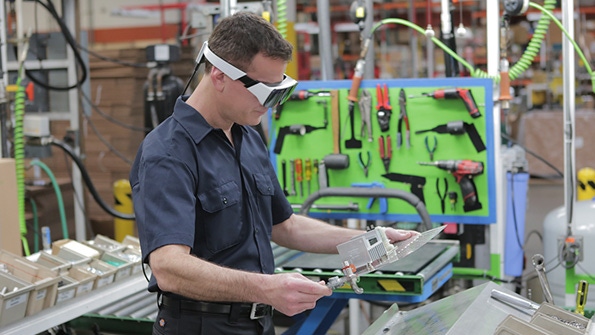5 Ways AR Will Change the Reality of Manufacturing
Augmented reality technology will play a significant role in improving productivity, efficiency, and safety in manufacturing. Here's your basic guide to understanding how.
September 11, 2018

|
Augmented reality is transforming the landscape of advanced manufacturing by allowing hands-free operation for plant floor personnel to maintain and troubleshoot industrial equipment. (Image source: Industry Week) |
Augmented reality (AR) systems, which overlay digital elements onto a person's real-world view, first appeared in the early 1990s. They have now impacted several markets, such as education, healthcare, entertainment, and gaming. The manufacturing market has recently joined the ranks of these industries by immersing maintenance, production technicians, and training personnel in the world of AR.
Here's a basic rundown of how AR will play a significant role in improving productivity, efficiency, and safety in manufacturing as the technology continues to improve:
1.) AR Hardware on the Factory Floor
|
RealWear’s HMT-1Z1 augmented reality headset provides hands-free operation for industrial maintenance personnel. (Image source: RealWear) |
RealWear’s HMT-1Z1 headset is a prime example of AR hardware being adapted for the industrial space. RealWear has developed headsets that incorporate all the hardware components to a pair of glasses attached to a helmet. The AR glasses resemble an industrial version of the original Google Glass. The concept behind the industrial AR gear is to immerse the industrial plant personnel with digital data from technical documents and streaming video to aid in monitoring manufacturing processes or help in troubleshooting control systems.
The hardware components required for implementing plant floor applications consist of a processor, display, sensors, and input devices. At the heart of the RealWear’s system architecture is a 2.0 GHz, 8-core Qualcomm Snapdragon processor. Included with the 14-nm technology is an Adreno 506 Graphics Processor Unit (GPU) for supporting high definition 1080p multimedia. The headset has four digital microphones with active noise cancellation and a voice recognition feature. Also, the wireless connectivity technology for the RealWear’s HMT-1Z1 AR headset includes Bluetooth Low Energy (BLE) 4.1 and IEEE 802.11a/b/g/n/ac WiFi specifications.
2.) AR for Upskilling
|
AR is allowing industrial OEMs to view product improvements without building costly physical prototypes. (Image source: ABI Research) |
Aside from providing digital documentation for monitoring and repair of industrial maintenance operations, AR is providing upskilling technologies to help production workers. Upskilling is the integration between industrial workers and smart machines. Primarily, AR augments production workers’ abilities to dramatically improve performance, provide industrial safety, and increase worker satisfaction. Examples of deployed upskilling technologies can be seen in the repair of industrial equipment, such as conveyor systems or automation production lines. Computer images, graphics, and text information can be overlayed and displayed using headsets or mobile devices, such as smartphones and tablets.
RELATED ARTICLES:
3.) AR for Productivity
AR can also be deployed in wearable devices used in industrial and manufacturing facilities to increase worker productivity on a variety of installation, monitoring, and troubleshooting tasks. Delivering accurate data when needed is the real power behind using wearable AR devices within industrial and manufacturing settings. The information is presented in the technician’s line of sight, leaving the production personnel’s hands free so work can continue without interruption. In 2017, GE documented a use case where a technician wiring a wind turbine control panel was recorded using manual work instruction sheets versus an AR headset. The AR headset improves the technician's wiring performance by 34%.
4.) AR for Inspection and Maintenance
|
The SART system enables "inspection time to be optimized while reducing the risk of penalties relating to deviations in conformity." (Image source: Airbus) |
For industrial inspection and maintenance, AR can improve task time and aid in detecting errors. Airbus had deployed AR technology to improve quality control and increase efficiency at its installation and inspection facilities since 2011. The company's Supply Augmented Reality Tool (SART) allows maintenance personnel to identify faulty parts requiring repair or replacement using digital enabled overlays on real system components.
5.) AR in Production Design
|
Ford Motor Co. is deploying Microsoft’s HoloLens for digital prototyping of vehicle features. (Image source: Ford Motor Co.) |
Developers are using mixed AR in the production design stage of manufacturing. With AR, developers can rapidly make changes and improvements prior to products going into manufacturing and modeling processes. Product designers at Ford have been using the Microsoft HoloLens to rapidly make changes to automobiles since 2017. Traditionally, clay models were built and used for such vehicle design change activities. The HoloLens allows product designers to overlay digital features onto physical vehicle prototypes. This process reduces the product development cycle time and cost associated with creating automobile clay models.
Don Wilcher is a passionate teacher of electronics technology and an electrical engineer with 26 years of industrial experience. He’s worked on industrial robotics systems, automotive electronic modules/systems, and embedded wireless controls for small consumer appliances. He’s also an author, writing DIY project books on electronics and robotics technologies.
|
About the Author(s)
You May Also Like








.jpg?width=300&auto=webp&quality=80&disable=upscale)


